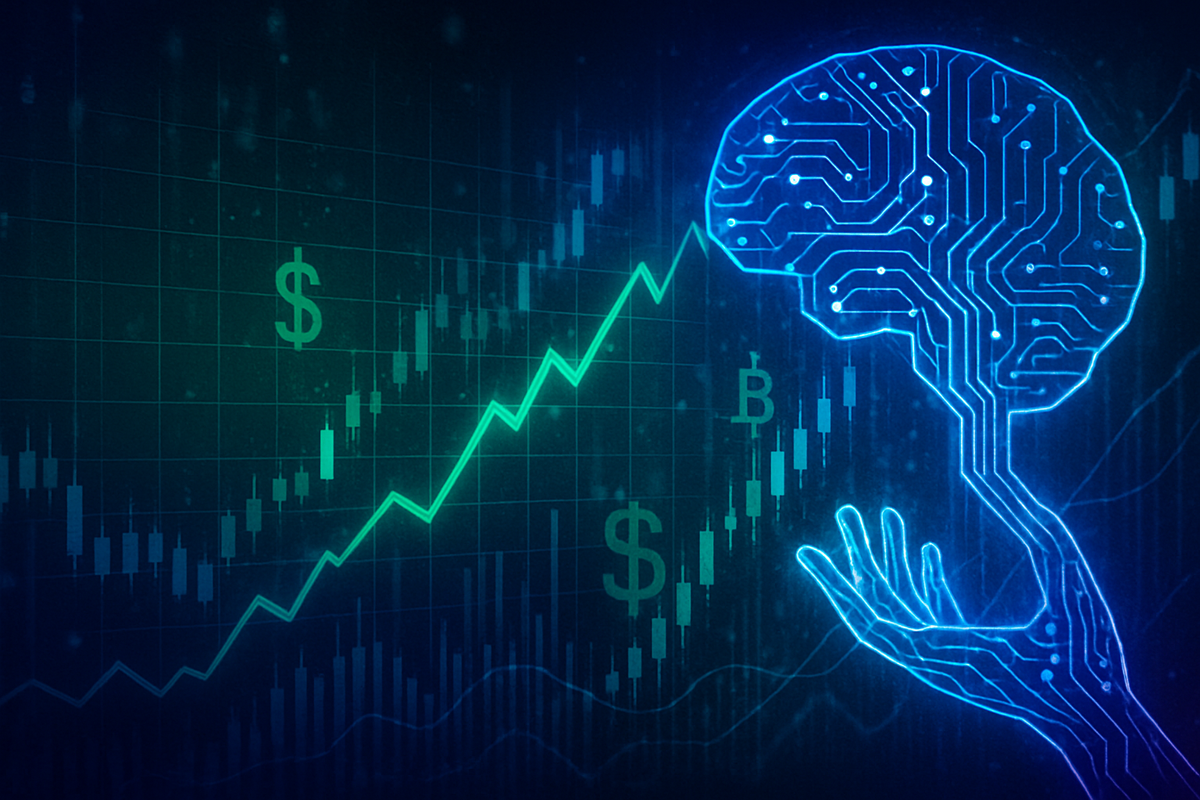
As of October 10, 2025, the relentless and escalating demand for Artificial Intelligence (AI) continues to be the undisputed engine powering global stock market performance, pushing major indices to unprecedented highs. This technological revolution, characterized by a narrative of innovation meeting insatiable corporate and consumer needs, has translated into soaring stock prices and market capitalizations for companies at the forefront of AI infrastructure, advanced chips, and sophisticated software solutions. The S&P 500, for instance, has surged past 6,500 points in Q3 2025, a testament to the robust performance of a select group of technology giants heavily invested in AI.
However, this pervasive optimism is increasingly shadowed by a growing chorus of warnings from financial institutions and analysts. Concerns over stretched valuations, the sustainability of the current tech-led rally, and the potential for an "AI bubble" are prompting a noticeable shift towards caution among investors. While AI's transformative power is undeniable, the market is grappling with the dual reality of explosive growth and the inherent risks associated with such rapid, concentrated expansion.
The AI Ascent: A Market Redefined by Innovation and Infrastructure
The current market landscape is profoundly shaped by the insatiable appetite for AI capabilities. What began as a nascent technological frontier has, by October 2025, evolved into the dominant force dictating market movements and valuations. The most prominent manifestation of this phenomenon is the unprecedented rise of a handful of AI-centric companies, often dubbed the "Magnificent Seven," which now command a substantial share of the S&P 500's market capitalization. Their sustained performance, fueled by massive capital expenditures and groundbreaking innovations, has become a critical barometer for the broader market's health.
The timeline of AI's accelerated influence can be traced back through several key developments. The rapid advancements in generative AI and large language models (LLMs) over the past 18-24 months have been particularly pivotal. These breakthroughs, requiring immense computational power, have created an unprecedented demand for specialized hardware. This demand began to significantly impact the stock market in late 2023 and early 2024, with semiconductor companies like Nvidia (NASDAQ: NVDA) and Advanced Micro Devices (NASDAQ: AMD) seeing their valuations skyrocket. Nvidia, in particular, has seen its stock climb approximately 40% so far in 2025, solidifying its position as the world's most valuable public company, a direct reflection of its indispensable role in AI infrastructure.
Key players driving this AI-fueled market rally extend beyond just chipmakers. Cloud computing providers such as Microsoft (NASDAQ: MSFT), Amazon (NASDAQ: AMZN), and Alphabet (NASDAQ: GOOGL) (Google's parent company) are pouring billions into expanding their generative AI infrastructure, with collective capital expenditures expected to reach around $200 billion in 2025, over $90 billion specifically for AI. Data center infrastructure specialists like Vertiv (NYSE: VRT), Arista Networks (NYSE: ANET), and Applied Digital (NASDAQ: APLD) are also experiencing booming demand. Furthermore, the immense energy requirements of AI data centers are creating a ripple effect, benefiting the utility sector. Initial market reactions have been characterized by fervent investor enthusiasm, leading to record valuations for AI-linked stocks, but also by increasing concerns about potential overvaluation and the sustainability of this concentrated growth. This has led to discussions among analysts about the potential for a sharp correction, particularly in high-growth technology firms, which could trigger a significant repricing across US dollar assets.
The AI Divide: Who Prospers and Who Faces the Headwinds
The pervasive influence of AI demand has created a distinct divide in the market, clearly delineating the beneficiaries from those facing significant challenges. At the forefront of the AI boom are the companies providing the foundational hardware, software, and cloud infrastructure that power this technological revolution.
The Winners: Semiconductor giants continue to reap immense rewards. NVIDIA Corporation (NASDAQ: NVDA) remains the undisputed leader, with its Graphics Processing Units (GPUs) being indispensable for AI computations, reflected in its dominant market position. Advanced Micro Devices Inc. (NASDAQ: AMD) is also a critical player, offering high-performance chips for data centers and AI workloads. ASML Holding N.V. (NASDAQ: ASML) plays a crucial, albeit indirect, role as the sole provider of advanced lithography equipment essential for manufacturing these cutting-edge chips. Beyond hardware, cloud service providers are massive beneficiaries. Microsoft Corporation (NASDAQ: MSFT), through Azure and its strategic investment in OpenAI, and Alphabet Inc. (NASDAQ: GOOGL, GOOG), with Google Cloud, are seeing substantial revenue growth as businesses migrate their AI operations to the cloud. Amazon.com Inc. (NASDAQ: AMZN) with AWS, also stands as a major enabler of AI deployment at scale. Companies specializing in AI infrastructure and data centers are also thriving, including Super Micro Computer Inc. (NASDAQ: SMCI), which provides critical server and storage solutions, and Applied Digital (NASDAQ: APLD), a data center service provider experiencing surging revenue. Data analytics firms like Palantir Technologies Inc. (NYSE: PLTR) are leveraging AI to offer sophisticated platforms for government and corporate clients, seeing impressive returns. Even companies like Meta Platforms (NASDAQ: META) are benefiting from AI advancements enhancing their core advertising and user engagement models. Other notable winners include Broadcom Inc. (NASDAQ: AVGO) with its semiconductor solutions, Snowflake Inc. (NYSE: SNOW) for cloud-based data warehousing, and Oracle Corp. (NYSE: ORCL) successfully integrating AI into its cloud and database offerings.
The Challengers: While the upside for AI enablers is clear, the disruptive nature of AI also presents significant headwinds for other sectors and roles, primarily through automation, increased competition, and the need for rapid adaptation. Industries such as manufacturing and retail have already seen millions of jobs displaced globally due to the automation of repetitive tasks and the rise of self-checkout systems. The transportation sector faces a looming threat from autonomous vehicles, potentially eliminating a large percentage of driving jobs. In customer service and telemarketing, AI chatbots are increasingly handling routine inquiries, reducing the demand for human representatives. Even white-collar professions are not immune; specific roles within banking & finance (e.g., transaction processing), legal services (document review), and journalism (AI-generated news) are seeing increased automation. Occupations like computer programmers, accountants, auditors, and administrative assistants are identified as being at high risk of displacement. Furthermore, smaller companies heavily reliant on AI for future growth but lacking the financial might of tech giants could struggle to keep pace with the rapid innovation and significant capital investment required, potentially finding themselves at a disadvantage in a market increasingly dominated by a few well-resourced players. A correction in the "AI bubble" could also disproportionately affect overleveraged or fundamentally weak firms, regardless of their AI aspirations.
Beyond the Hype: AI's Broad Impact and Regulatory Horizon
The surging demand for AI is not merely a transient market phenomenon but a profound structural shift, weaving itself into the fabric of virtually every industry and reshaping competitive dynamics, supply chains, and regulatory landscapes. As of October 2025, AI has moved past isolated pilot projects to become a strategic imperative for businesses worldwide.
AI's integration into broader industry trends is ubiquitous. In healthcare, AI copilots are revolutionizing diagnostics and documentation, alleviating physician burnout. Manufacturing is adopting digital twin technology for smarter factories, optimizing energy use and predicting equipment failures. Retail and e-commerce are leveraging generative AI for personalized marketing and efficient inventory management. The financial sector is utilizing AI for enhanced fraud detection and risk management, while even sustainability efforts benefit from AI's ability to track emissions and model energy efficiency. This widespread adoption underscores AI's role as a "force multiplier," promising significant gains in productivity, speed to market, and revenue across diverse sectors. The global AI market, projected to exceed $1.8 trillion by 2030, highlights the scale of this transformation, with 82% of companies already engaged in AI implementation.
These advancements create significant ripple effects. Competitors face immense pressure to integrate AI, with those failing to adapt risking obsolescence. Supply chains are being transformed, with AI enabling predictive precision in inventory and real-time risk management, leading to greater resilience but also increased complexity and potential shortages in key components like consumer electronics. The semiconductor industry, as a foundational enabler, continues to experience massive growth, but also faces the challenge of potential supply-demand imbalances. This era is also fostering new partnerships and strategic acquisitions as companies seek to bolster their AI capabilities, with a strong emphasis on leveraging institutional knowledge and proprietary data. Simultaneously, the workforce is undergoing a significant transformation, with the rise of AI agents performing tasks traditionally outsourced, necessitating widespread upskilling and reskilling efforts.
The rapid advancement of AI has also thrust regulatory and policy implications to the forefront. Governments globally are scrambling to establish comprehensive frameworks to address AI's ethical challenges. The EU AI Act, adopted in 2024, stands as a landmark risk-based approach, categorizing AI systems and banning unacceptable risks. In the U.S., executive orders and state-level legislation (e.g., California's AI Transparency Act, Colorado's AI Act) are shaping a complex landscape, focusing on ethical use, data privacy, and transparency. Core ethical principles such as accountability, fairness, and safety are central to these discussions, with particular attention to preventing algorithmic bias and ensuring human oversight. The reliance of AI on vast data volumes makes data privacy a paramount concern, driving the development of regulations around consent and data ownership. While international cooperation exists, the regulatory landscape remains fragmented, reflecting differing national priorities between fostering innovation and ensuring national security.
Historically, the current AI boom draws frequent comparisons to the dot-com bubble of the late 1990s and early 2000s, given the massive investment, soaring valuations, and speculative frenzy. However, crucial distinctions exist. Today's leading AI companies often boast stronger fundamentals, proven profitability, and diverse revenue streams, unlike many dot-com startups. The underlying infrastructure is more mature, productivity gains are more visible, and there's greater institutional support. While the internet revolution fundamentally changed how we live and work, AI's impact is expected to be even broader, extending beyond automation to discovering entirely new capabilities and driving long-term economic growth. The current investment in AI, largely equity-funded from substantial cash flows, also suggests a potentially more stable foundation than the speculative debt-fueled investments of the dot-com era.
The Road Ahead: Navigating AI's Evolving Market Landscape
The trajectory of AI's influence on the stock market presents a dynamic landscape, characterized by both immense potential and significant challenges, demanding strategic foresight from companies and investors alike.
In the short term (late 2025 - 2026), the market is expected to pivot from broad experimentation with generative AI to more strategic, scaled adoption across enterprises. Companies will increasingly embed AI into critical business workflows to achieve measurable productivity gains and cost savings, driving efficiency across diverse sectors. The demand for advanced chips, cloud computing, and related infrastructure will remain a dominant growth driver, with investment focus gradually broadening beyond early hardware beneficiaries to include software, services, and various industrial applications. However, the ongoing debate about a potential "AI bubble" suggests that while continued growth is anticipated by some, others foresee a potential "reset" or "drawdown" in valuations, particularly for companies with less robust fundamentals.
Looking further ahead (2027 - 2030 and beyond), AI is poised to fundamentally reshape industries, with the global AI market forecast to reach trillions of dollars. Projections indicate AI could add $15.7 trillion to the global economy by 2030, driven by profound transformations in healthcare (diagnostics, personalized medicine), manufacturing (automation, predictive maintenance), and finance (algorithmic risk management). Breakthroughs in multimodal AI and the plausible development of Artificial General Intelligence (AGI) by 2030 are on the horizon, promising a continuous evolution towards more data-driven, automated, and personalized services across the economy. This structural growth theme is primarily backed by firms with the scale and capital to sustain long-term investment.
For companies, strategic pivots are imperative. AI must be deeply integrated into core business strategies, moving beyond mere tools to redefine business models, shifting towards "product-as-a-service" (PaaS) and enhancing personalization. Investing in high-quality data and robust infrastructure is paramount, as data remains the "lifeblood of effective AI systems." Addressing the pervasive skills shortage through training, hiring specialists, or collaborating with AI consultants is crucial. Furthermore, prioritizing ethical AI and regulatory compliance, particularly concerning transparency, bias, and data privacy, is non-negotiable in an increasingly scrutinized environment. Continuous evaluation and adaptation based on AI-driven analysis, rather than infrequent reviews, will be key to staying agile.
Market opportunities will continue to emerge in AI infrastructure development, specialized AI solutions for various industries, and new business models like "Agents-as-a-Service" (AaaS). Emerging markets, with their lack of legacy infrastructure, are also poised to capture a disproportionate share of AI's economic impact. However, significant challenges persist, including the high costs and technical complexity of AI adoption, pervasive data quality issues, the persistent skills gap, and evolving ethical and regulatory concerns. The surging energy demands of AI data centers also present a growing operational and environmental challenge. For investors, potential scenarios range from continued AI-driven growth favoring infrastructure and software leaders to a market correction due to overvaluation concerns. Opportunities will broaden across diverse sectors effectively leveraging AI. Strategic investment approaches, including AI-managed ETFs, a focus on strong fundamentals, diversification across AI applications, and robust risk management using AI systems, will be essential for navigating this complex and transformative period.
The AI Imperative: A Market Transformed
The continued influence of AI demand on overall stock market performance is not merely a passing trend but a profound, systemic transformation. As of October 2025, AI has firmly established itself as the primary engine of market growth, propelling key indices to record highs and rewarding companies at the cutting edge of AI infrastructure and application. The "Magnificent Seven" and other AI-centric firms have demonstrated unprecedented valuation increases, fueled by massive capital expenditures and relentless innovation.
Moving forward, the market will likely experience a strategic shift from broad AI experimentation to targeted, scaled integration, driving measurable productivity gains across industries. While the long-term outlook for AI-driven economic growth remains exceptionally strong, with projections of trillions added to the global economy by 2030, the short-term carries inherent volatility due to concerns over market concentration and potential overvaluation. The ongoing debate about an "AI bubble" underscores the need for cautious optimism.
For investors, the key takeaway is the imperative of a nuanced and adaptive strategy. While opportunities abound in core AI infrastructure, software, and specialized solutions across diverse sectors, vigilance against speculative excesses is crucial. A focus on companies with strong fundamentals, proven profitability, and clear, ethical AI implementation strategies will be paramount. Diversification across AI applications and leveraging advanced risk management tools will be essential. The market will continue to be shaped by AI's relentless evolution, regulatory developments, and the ability of companies to strategically adapt. Investors should closely watch for shifts in capital expenditure trends, the emergence of new AI-driven business models, and the ongoing global efforts to establish robust AI governance frameworks in the coming months.
This content is intended for informational purposes only and is not financial advice






